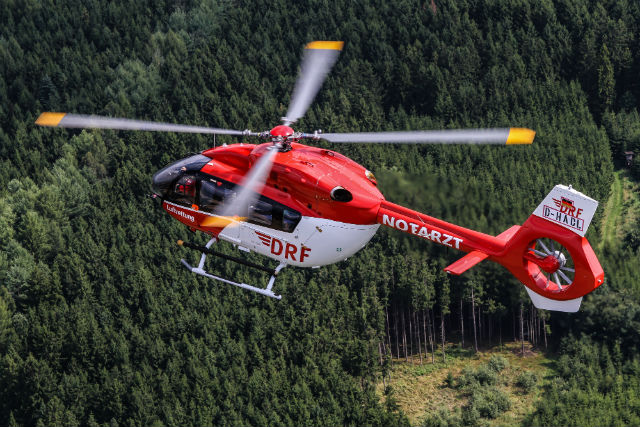Airbus Helicopters is hoping to capitalise on the smooth service entry of its new H145 – formerly the T2 variant of the long-running EC145 medium twin – and add extra capabilities to the baseline rotorcraft.
First delivery of the new Donauwörth, Germany-built model – which gains uprated 900shp (671kW) Turbomeca Arriel 2E engines, a shrouded anti-torque rotor and new carbonfibre tail boom – took place in July 2014 to German medical services provider DRF Luftrettung.
Since then, 43 helicopters have been handed over to 14 customers, accumulating a total 10,400 flight hours, says programme manager Dragos Grigorincu.
Availability is targeted at 85%, however Grigorincu believes it will be able to achieve over 90%.
“The overall statement coming from operators is that it has been a smooth entry into service,” he says, with unscheduled maintenance “kept to a minimum”.
Envelope expansion work has already been carried out, with test flights conducted in April and May this year in Bolivia to enable a certificated density altitude of 20,000ft from 2016.

Airbus Helicopters
Additional features will also be added to the Helionix avionics suite next year, including ADS-B Out, a synthetic vision system, digital maps, and localiser performance vertical approach guidance.
An iPad-based electronic flight bag with full connectivity is also being developed “over the next one to two years”, says Grigorincu.
A health monitoring system is also being rolled out this year, which includes engine vibration monitoring, largely driven by the requirement for the feature from operators in the offshore transportation segment, he says.
Although around 80% of deliveries so far have been to the emergency medical services sector, offshore operators are increasingly showing interest in the eight-passenger helicopter.
That has been underlined by a firm commitment signed on 2 December for 10 H145s from Mexico’s Pegaso for use in oil and gas operations. Deliveries are to start from 2017.
Backlog for the type now stands at 180 aircraft, a mixture of firm orders and options, says Grigorincu.
Production ramp-up of the new variant is increasing, from 13 last year to 40 in 2015, rising to a maximum of 60 next year.
However, the airframer continues to work through its backlog of older models, both the baseline helicopter and the stripped down EC145e – confusingly now marketed as the EC145 – with a combined 70 airframes still to build.
The vast majority of those are destined for the US Army’s UH-72 Lakota programme, with Donauwörth-built kits transferred to a facility in Columbus, Mississippi for final assembly.
Airbus Helicopters declines to be drawn on when it will phase out production of the older model, but this is unlikely to extend much beyond 2016.
Source: FlightGlobal.com


























